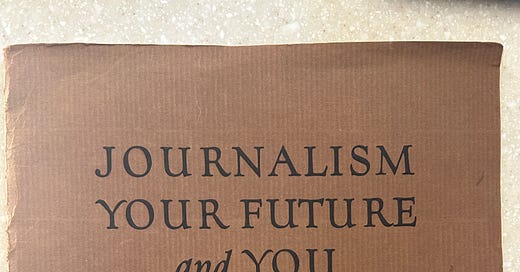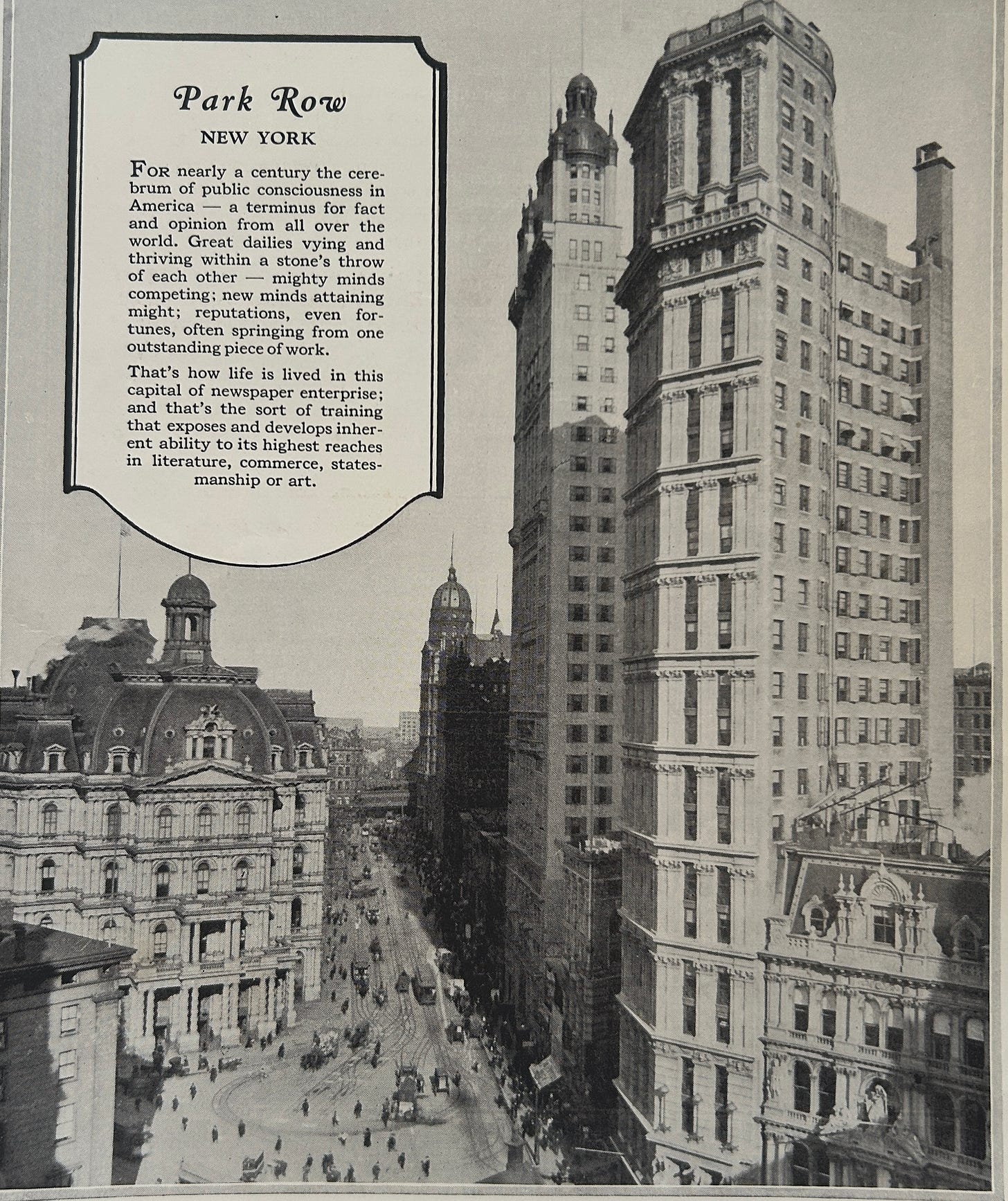Vocational seidlitz powder
First of two posts about a 1929 journalism text and what we can learn from it
A few years ago, my wife and I were poking around an antique store in Palmyra1 when I found this gem.
Journalism Your Future and You2 from the Newspaper Institute of America. Publication date, 1929.
You know I’m a sucker for old journalism texts. I find them to be fascinating windows into how journalists view themselves and their profession at a given historical moment. Plus, they’re just fun to read.
The experience of reading this particular book was a bit of a trip. So, open the brown cover, and we come to the title page, which presents us with the following:
Answering 10 questions that occur to most ambitious mortals - showing what they might mean to you - and leaving it to you to make a decision.
What makes newspaper people so sure of themselves?
Why “Once a newspaper man, always a newspaper man?”
What is there about newspaper training that makes it so desirable in other businesses?
How much writing ability does it take to gain a foothold in the profession?
How does journalism develop the ability to write fiction, magazine articles, stage plays, photodramas?
How can I get a job on a newspaper?
How well paid are newswriters?
What branch of writing offers most opportunity?
Is metropolitan newspaper experience vital to success as a writer?
Is it possible to get newspaper training without working on a newspaper?
OK …
Next up is a full-page photo of Park Row in 1920s NYC. Two 20-plus story buildings dominate the photo. This must have looked so glamorous at the time, because honestly, it’s kind of glamorous even 90+ years later.
There’s text in a little insert:
For nearly a century the cerebrum of public consciousness in America - a terminus for fact and opinion from all over the world. Great dailies vying and thriving with a stone’s throw of each other - mighty minds competing; new minds attaining mighty reputations, even fortunes, often springing from one outstanding piece of work.
That’s how life is lived in this capital of newspaper enterprise; and that’s the sort of training that exposes and develops inherent ability to its highest reaches in literature, commerce, statesmanship or art.
I mean, how cool does that make a newspaper job sound? It’s something straight out of a classic DC comic book.
Page 3 brings us a full-page letter from the stern-faced James McAlpine Pyle, the president of the Newspaper Institute of America.
“What is success? I’d say happiness” Banger of lede, James.
He spends his letter saying how important it is to be happy with your job. And if you’re not happy with your job - maybe a course in journalism is for you!
“No, I am not going to say that you ought to take a course in journalism as a sort of vocational seidlitz powder3. A born engineer should keep on with his blueprints. The man with instinct for trading should stick to his markets. Those whose destiny is science should never leave the laboratory.
But if you don’t know what you are - if you’re one of those people with an urge that seems to shoot off in dozens of different directions - or if you aren’t what you want to be - a try at journalism will bring you in closer contact with life and it opportunities and at the same time teach you self expression and writing.4 …
Training with the Newspaper Institute of America is not nearly a course - it is an experience.”
It’s here that the purpose of this little magazine booklet starts to become clear. It is an advertisement/catalog for Newspaper Institute of America training programs. In the parlance of that era, it was a correspondence course.
The first half of the book sells you on the career of being working in newspapers. The second half lays out the structure of the Newspaper Institute of America’s course of study.
Let’s start with the first half.
To sell a newspaper career, the book presents a hypothetical story where the reader is sent to cover a breaking news story, running through the process of tracking down the facts, getting an interview and doing whatever it takes to get the story. “Reach him if you have to hire steamboats, airplanes, submarines,” one caption reads.
Another essay presents the benefits of newspaper work.
You are constantly encountering new situations to meet which you must devise your own approach. You are no creature of dumb routine, no rule-book manikin. Your success, your job, the kind of service you give your readers depends upon your ability to think on your feet, in the run, standing, sitting, flying.
Above all, you must be fair. You serve no purpose by deception or exaggeration. People will lie to you. You must know when they lie — or at least learn when to doubt. Impulse will sway you. You must hold yourself in check. A half truth is no truth, so get the habit of learning both sides of the story.5
There are two pages featuring pictures of Titans of Industry (aka fancy looking old white dudes) with the running headline of “They’re Still Newspaper Men.”6
There are two pages answering the questions presented back on page one. One of the questions is “How well paid are newswriters?”
Here’s a table of their salaries with their 2024 adjusted-for-inflation equivalents
It should be pointed out that, adjusted for inflation, that “green reporter” salary in 1925 was a little less — but not by much — than what I made as a new reporter in 1999.
What stands out about the selling of a career in newspapers is how little it is about a career in newspapers.
The primary selling point of a job in newspapers in 1929 was how it would prepare you for other jobs. The Titans of Industry featured in the “I was a newspaper man once” pages are authors, professors, an explorer/biologist/archeologist/museum curator, and a bank vice president
In his introductory letter, Pyle writes:
And for the man or woman with real ambition toward authorship - real writing instinct - journalism will serve just as the life class serves the artist, just as mathematics serves the scientist. It will prove you to yourself, bring out your talent - and to a greater extent than any other training I know of, expose you to an illimitable number of chances to conceive and create, to write and to see.”
The essay that presents the reader the hypothetical of chasing down a story:
Every story, in every newspaper, is the product of real experience on the part of the man or woman responsible for it. That is the true explanation - simple, as must true explanations are - of the unmatched ability of newspaper trained men and women to achieve literary success. They know where they write. They practice writing accurately from facts - which has been the basis of all successful writing from imagination
It’s interesting that a newspaper job was not a career in itself. It served as training for bigger, better, more important things. This is consistent with other contemporary accounts. In the excellent book, The Rose Man of Sing Sing, James McGrath Morris wrote that journalists in early 20th century New York often stayed on their jobs for only five to seven years. “They saw it as a stepping-stone to a career in law, politics, or business, often through the contacts they made as reporters”
There are no mentions of the First Amendment, no reminders of the importance role journalism plays in our society, no discussion of uprooting corruption or serving as the the public’s watchdog. Nothing that we would expect to see in a selling of newspaper work in today’s world. It’s all about writing and storytelling. It’s about what newspaper jobs can do for you personally, not what you as a newspaper reporter could do for the world with your work.
It’s also noteworthy that in 13 pages, the word journalism only appears seven times — two of them being in the title. This is about newspaper work. I find that distinction interesting.
From the essay about life at a newspaper:
Remember, we are what we repeatedly do
If you would learn to write - start writing. The Newspaper Institute method will start you and keep you steadily at it for as long as ten months - or longer, if you wish.
Next week, we dig into the method. As someone who runs the 2024 equivalent of a correspondence course, I’ll go through the Newspaper Institute of America’s program, evaluate it, and see what I can maybe learn from it.
The store is right across the street from the site where Joseph Smith had the original version of the Book of Mormon printed.
Commas are not a part of this future, apparently.
This is, and I cannot stress how much I am not kidding here, a laxative. https://en.wikipedia.org/wiki/Seidlitz_powders
I’m not sure I should be taking journalism career advice from a guy who puts this many dashes in a single sentence.
Yes, this whole paragraph is included as an extended subtweet to the political press of 2024. And that last line is a nice reminder that the “both sides” thing is not new at all.
In fairness, in most of this booklet the phrase “men and women” is used instead of just men. Given that this is 1929, I think we can call it an enormous win.







I mean, if you think about the college daily papers publishing since this era .. a great majority of those running those newsrooms every year go on do to that very thing … something else. With papers that continue to exist where there’s never been a journalism program. And my most treasured colleagues and marketplace colleagues often share a common bond of past newspaper/journalism work experience. They most often possess that specific set of skills that training course describes …